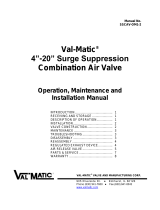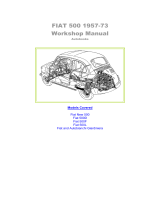Page is loading ...

Manual No.
ARCL-OM2-1
Air Release Valve
Series 61
(Compound Lever Type)
Operation, Maintenance and
Installation Manual
INTRODUCTION ............................................ 1
RECEIVING AND STORAGE ........................ 1
DESCRIPTION OF OPERATION ................... 1
INSTALLATION ............................................. 2
VALVE CONSTRUCTION .............................. 2
MAINTENANCE ............................................. 3
TROUBLESHOOTING ................................... 3
DISASSEMBLY ............................................. 3
REASSEMBLY .............................................. 4
PARTS & SERVICE ....................................... 4
WARRANTY .................................................. 5
VAL-MATIC
®
VALVE AND MANUFACTURING CORP.
905 Riverside Dr. ● Elmhurst, IL 60126
Phone (630) 941-7600 ● Fax (630) 941-8042
www.valmatic.com

1
VAL-MATIC'S AIR RELEASE VALVE
(Compound Lever Type)
OPERATION, MAINTENANCE AND INSTALLATION
INTRODUCTION
This manual will provide you with the information
to properly install and maintain the valve to
ensure a long service life. The Air Release Valve
has been designed with stainless steel trim to
give years of trouble-free operation. The Air
Release Valve is typically mounted at the high
points in a piping system to automatically remove
pockets of air as they accumulate. The valve can
also be used to slowly release air in tanks and
pump casings.
Note: This valve is not intended for fluids
containing suspended solids such as wastewater.
For wastewater and other high turbidity
applications, use Val-Matic Series 48A & 49A
Sewage Air Release Valves.
The valve is a float-operated, resilient-seated
valve designed to handle clean fluids. The
Maximum Working Pressure and Model No. are
stamped on the nameplate for reference.
Note: Low Durometer seats are available for low
pressure applications.
RECEIVING AND STORAGE
Inspect valves upon receipt for damage in
shipment. Handle all valves carefully without
dropping. Valves should remain boxed, clean and
dry until installed to prevent weather related
damage. For long term storage greater than six
months, the valve must remain in the box and
stored indoors. Do not expose valve to sunlight
or ozone for any extended period.
FIGURE 1. Compound Lever Air Release Valve
DESCRIPTION OF OPERATION
The Air Release Valve is designed to
automatically remove air pockets at the high
points in a piping system. The valve, as shipped,
is a normally open valve and will slowly vent air
through the top orifice. As fluid enters the valve,
the float will rise, closing the orifice. As air
accumulates in the piping system and enters the
valve, the float drops allowing the venting orifice
to open.
The lever mechanism provides mechanical
advantage for the float. During system operation,
the pipeline pressure exerts a strong upward
force on the sealing component, the orifice
button. The lever mechanism magnifies the
weight of the float so that the orifice will open
under high pipeline pressures. Additional ports
are provided for flushing, testing and draining
purposes.
CAUTION
This valve is not intended for fuel service
or fluids containing suspended solids.

2
INSTALLATION
The installation of the valve is important for its
proper operation. Valves must be installed at the
system high points in the vertical position with the
inlet down. For pipeline service, a vault with
freeze protection, adequate screened venting,
and drainage should be provided. During
closure, some fluid discharge will occur so vent
lines should extend to an open drain area in plant
service. A shut-off valve should be installed
below the valve in the event servicing is required.
VALVE CONSTRUCTION
The standard Air Release Valve body and cover
are cast iron. See the specific Materials List
submitted for the order if other than standard cast
iron construction. All internal components are
stainless steel with the exception of the orifice
button which is resilient. The general details of
construction are illustrated in Figure 2. The body
(1) is threaded for connection to the pipeline. The
seat (4) is threaded into the cast cover (2).
Table 1.
A
ir Release
V
alve Parts List
Item Description Material
1Bod
y
Cast Iron
2 Cover Cast Iron
4 Seat* Stainless Steel
5 Float* Stainless Steel
6Gasket* Non-
A
sbestos
7 Cover Bol
t
A
llo
y
Steel
9 Float Arm Base* Stainless Steel
10 Float Arm* Stainless Steel
11 Orifice Button* Buna-N
12 Pivot Pin* Stainless Steel
13 Retainin
g
Rin
g
* Stainless Steel
14 Pipe Plu
g
Iron
15 Cushion Assembly* Buna-N/SS
Steel
17 Float Retainer* Stainless Steel
18 Lock Nut* Stainless Steel
19 Link* Stainless Steel
20
Base Retaining
Screw
Stainless Steel
21 Button
A
rm Base* Stainless Steel
22 Orifice Button
A
rm& Stainless Steel
28 Pipe Plu
g
* Steel
30 Lock Washer* Stainless Steel
* Recommended Repair Part Kit
x
FIGURE 2. Compound Lever Air Release Valve
CAUTION
Install valve with "INLET" port down or
leakage will occur.

3
MAINTENANCE
The Air Release Valve requires no scheduled
lubrication or maintenance.
INSPECTION: Periodic inspection to verify
operation can be performed. A manual drain
valve can be installed in the lower drain plug to
perform this operation as shown in Figure 3.
FIGURE 3. Inspection Piping
1. With the inlet shutoff valve open, partially open
the drain valve until flow can be heard. If the
air valve is working properly, water should be
exhausted from the drain valve. If air is
exhausted, follow steps 2-6.
2. Close the inlet shutoff valve.
3. Slowly open the drain valve to allow the fluid
in the valve to drain.
4. Close the drain valve.
5. Slowly open the inlet shutoff valve to fill the
valve with water. Observe the seating action
and verify that the valve closes without
leakage.
6. If leakage occurs, the valve should be
removed and inspected for wear or possible
damage from foreign matter.
TROUBLESHOOTING
Several problems and solutions are presented
below to assist you in troubleshooting the valve
assembly in an efficient manner.
• Leakage at Bottom Connection: Tighten valve
threaded connection. If leak persists, remove
valve and seal threads with thread sealant.
• Leakage at Cover: Tighten bolts per Table 2,
replace gasket.
• Valve Leaks when Closed: Flush valve to
remove debris. Disassemble and inspect
seat, orifice button, and float. NOTE: Many
floats contain sand for weight but if water is
detected, replace float.
• Valve not Venting Air: Check that operating
pressure does not exceed Working Pressure
on nameplate. Perform inspection steps 2-6
and disassemble valve if problem persists.
DISASSEMBLY
The valve can be disassembled without removing
it from the pipeline. Or for convenience, the valve
can be removed from the line. All work on the
valve should be performed by a skilled mechanic
with proper tools. No special tools are required.
1. Close inlet shut-off valve. Open drain valve or
remove drain plug. Remove the cover bolts
(7) on the top cover.
2. Pry cover (2) loose and lift off valve body.
3. Remove the 2 retainer rings (13) and pivot
pins (12) that pass through the float arm frame
(9) and button arm base (21). The float (5) and
linkage will be free from the cover. Disconnect
float from float arm (10).
WARNING
The valve must be drained before
removing the cover or pressure may be
released causing injury.

4
DISASSEMBLY (Cont'd)
4. To remove float arm base (9) and button arm
base (21), remove the base retaining screws
(20). Rotate seat (4) counter-clockwise to
remove.
5. Remove locknut (18), lockwasher (30) and
orifice button (11) from orifice button arm (22).
6. Clean and inspect parts. Note: some floats
contain sand for extra weight; if water is
detected, replace float. Replace worn parts as
necessary.
REASSEMBLY
All parts must be cleaned and gasket surfaces
should be cleaned with a stiff wire brush in the
direction of the serrations or machine marks.
Worn parts, gaskets and seals should be
replaced during reassembly. Refer to Figure 2 on
page 2.
1. Apply Loctite PST No. 565 thread sealant to
seat (4) and assemble to cover with maximum
torque of 20 ft-lbs; DO NOT OVER-TORQUE.
2. Assemble float arm base (9) and button arm
base (21) to cover. Secure with screws (20).
3. Install new orifice button (11) flush to orifice
button arm (22). Assemble lockwasher (30)
and locknut (18) over orifice button but do not
tighten.
4. Connect arms (10 and 22) and assemble to
bases (9 and 21) with three pivot pins (12) and
retaining rings (13); rings should snap over
pins.
5. Adjust orifice button (11) so that orifice button
arm (22) slopes up about 1/16" when resting
gently against seat (4) as shown in Figure 4.
Secure button by tightening lockwasher (34)
and nut (18).
6. Attach float (5) to the float arm (10) with the
float retainer screw (17). Float should move
freely pressing the orifice button (11) against
the seat (4) when pushed upward. Verify that
all retainer rings (13) are properly secured.
7. Assemble gasket (6) and cover (2) over bolt
holes in body (1).
8. Insert lubricated bolts (7) and tighten to the
torques listed in Table 2.
9. Place valve back in service. Refer to the
Installation instructions on page 2. Slowly
open inlet isolation valve.
Table 2. Valve Bolt Torques
Size Torque
(
ft-lbs
)
1/4” 5-10
5/16” 10-15
3/8” 20-30
3/4” 150-250
PARTS AND SERVICE
Parts and service are available from your local
representative or the factory. Make note of the
valve Model No and Working Pressure located on
the valve nameplate and contact:
Val-Matic Valve and Mfg. Corp.
905 Riverside Drive
Elmhurst, IL 60126
Phone: (630) 941-7600
Fax: (630) 941-8042
www.valmatic.com
A sales representative will quote prices for parts
or arrange for service as needed.

5
VAL-MATIC
®
VALVE AND MANUFACTURING CORP.
905 Riverside Dr. ● Elmhurst, IL 60126
Phone (630) 941-7600 ● Fax (630) 941-8042
www.valmatic.com
LIMITED WARRANTY
All products are warranted to be free of defects in material and workmanship for a period of one year from the date of
shipment, subject to the limitations below.
If the purchaser believes a product is defective, the purchaser shall: (a) Notify the manufacturer, state the alleged defect and
request permission to return the product; (b) if permission is given, return the product with transportation prepaid. If the
product is accepted for return and found to be defective, the manufacturer will, at his discretion, either repair or replace the
product, f.o.b. factory, within 60 days of receipt, or refund the purchase price. Other than to repair, replace or refund as
described above, purchaser agrees that manufacturer shall not be liable for any loss, costs, expenses or damages of any
kind arising out of the product, its use, installation or replacement, labeling, instructions, information or technical data of any
kind, description of product use, sample or model, warnings or lack of any of the foregoing. NO OTHER WARRANTIES,
WRITTEN OR ORAL, EXPRESS OR IMPLIED, INCLUDING THE WARRANTIES OF FITNESS FOR A PARTICULAR
PURPOSE AND MERCHANTABILITY, ARE MADE OR AUTHORIZED. NO AFFIRMATION OF FACT, PROMISE,
DESCRIPTION OF PRODUCT OF USE OR SAMPLE OR MODEL SHALL CREATE ANY WARRANTY FROM
MANUFACTURER, UNLESS SIGNED BY THE PRESIDENT OF THE MANUFACTURER. These products are not
manufactured
,
sold or intended for
p
ersonal
,
famil
y
or household
p
ur
p
oses.
/











